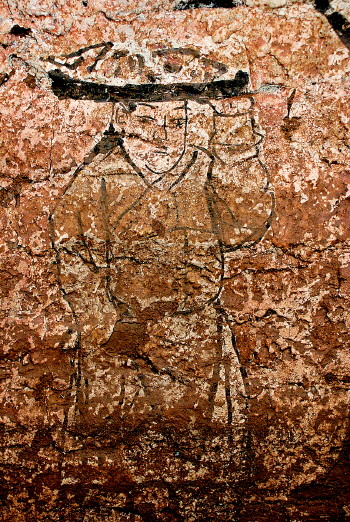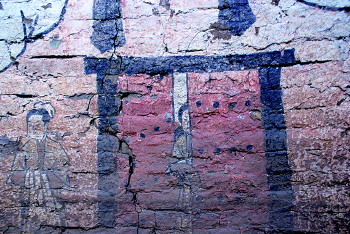 top tray.
top tray.  woman Kai men figure.
woman Kai men figure. Article / newspaper reporter Guo Xuejun
the archaeological excavation of the Yuan Dynasty family tombs at the East Yao village of the Zhangqiu Saint well office is near the end of the day. In April 18th, the reporter found that 5 of the 6 brick tombs of the round vault have been excavated, and the tomb walls of the ancient tombs are full of fine frescoes and brick carvings, and the preservation is quite complete. But reporters learned that this place is in the scope of a construction site. If the tomb is not removed in time after the excavation is completed, it may be destroyed and built. The retention of these exquisite tombs has become a matter of concern.
1
the mural color is gorgeous, the life taste is full of
"so good mural, it is really beautiful!" on the 18 morning, in the east of the Zhangqiu mountain scenic area east of the East Yao village archaeological site, facing a unique and exquisite murals of ancient tombs, the scene visitors can not resist tut TUT of admiration.
the reporter saw in the scene that, within the range of about 800 square meters, 6 tombs are concentrated. They are different from the ground, and the form of the burial is a brick tomb at the top of the round vault. 5 of them are Mural Tombs. In a grave's tomb, there are two chronological notes, one written with cinnabar, "Yuan Zhen three February 3rd", and the other is the two character "Yuan Zhen" written by the ink. The characters and scenes in frescoes are colorful and lifelike. They are the living scenes of the tomb owners in song and Yuan Dynasties. According to the verification, "Yuan Zhen" is one of the Yuan Cheng Chan number, "Yuan Zhen three years", that is, 1297.
"old people die as things happen, all of which reflect the scene of life at that time." An expert at the scene, pointing to a picture of 4 characters, said it should be a scene of waiting for a guest, the host sitting and the sitting guest were talking, and a waiter standing next to it. On the table there are tea sets and tableware with tablespoons. Beside the characters are two paintings with bamboo.
another picture is a scene where 5 characters meet. The picture seems to be a scene of enjoying the scenery together with the three waiters. The men and women sat on the chair, and 3 waiters stood by. The expert said one of the waiters was very much like a hu man.
there is also a frescoes full of life, depicting a man holding a broom as if he had just finished cleaning the yard, and there was a chicken standing on the ground next to him. The reporter consulted Mr. Li Wanpeng, honorary president of the provincial folklore society. He said that the design was early in the Han Dynasty, which meant clearing the courtyard to welcome visitors.
"each tomb's murals are basically surrounded by all the way up to the top." After seeing the frescoes, experts at the scene said that although these tombs were not buried in the same year, the style of the murals was very similar. It may be from one hand.
2
is facing the tomb gate is the "woman opening door" map
the reporter saw that on the inside wall of the three Yuan Dynasty tombs, there is a "woman opening" pattern in the place where the tomb is facing. The pictures of the three designs are very similar. They are painted with a pair of painted doors and black doorframes in the middle. In the middle of the two door, there was a narrow door seam showing a half face of a beautiful woman with a folding fan. On the both sides of the gate, according to the male left female right pattern, there are two men and one woman. The barman was on the head of a big plate like a food, and the waitress was dressed in decent clothes, a hair ornament, his hands on his chest, and standing there. "
" "the" "women's door" pattern is a common pattern in the art of Chinese burial, the Han Dynasty has, because the people who have opened the door are most women, so they have their name. " Experts at the scene told reporters that the meaning of this pattern has different claims. The image of Kai men in Sichuan is closely related to the belief of the West mother, and the opening door is the envoy of the fairyland or the queen of the West. The image of Kai men in Shandong and Northern Jiangsu is more mundane, showing some ideal social gender order.
experts believe that the "woman opening" pattern may reveal an unrestricted basic male imagination for a happy life after death: women standing in front of all the doors of all rooms, watching visitors and welcoming them into the house. The woman who opened the door became a passage between the real world and the mythological world.
experts also believe that the building in the women's door opening pattern is the main body of the picture. Tall buildings provide a space for the souls of the dead to rest and live in. In this "ideal home", the dead need the waiter to take care of their lives, which is more suitable for women.
3
there are two strange "eyes"
on the tomb door. The reporters saw that these tombs were not only exquisite in murals, but also exquisite in brick carving. There are sophisticated brackets, imitation houses, and animal heads like pigs or tigers. Among them, several brick carvings are vivid and vivid. One is the coloured brick carving on the lampstand, which is skillfully integrated with a maid beside the murals, and the standing maid is lighting the oil lamp on the lampstand. Experts at the scene say that the combination of brick carving and fresco is quite unique.
another brick carving is a table of two chairs, with a lamp stand beside it. The chairs and tables are very real, just like someone just sat on it.
the most amazing thing is that there is a pair of "eye" brick carving above the tomb door. One of the coloured paintings on one eye has been peeled off, and the other one has painted white circles with black circles.
Why do you have eyes on the tomb? "" what are these eyes looking at? "" is it a look at the future? "" is it a look at the coming life and the future? "An expert at the scene said that this situation has not been met before, and it is not well read.
a reporter then asked an expert from the Provincial Institute of cultural relics and archaeology. He told reporters after looking at the picture that the eyes were rare but similar. In fact, the whole tomb door is a deformed animal pattern. The brick carvings on the top are animal eyes, the middle brick carving is the nose, and the lower door is a big beast mouth. He said that this kind of animal face pattern was more numerous in Shang Dynasty artifacts, and might appear to be a tomb in the Yuan Dynasty tombs.